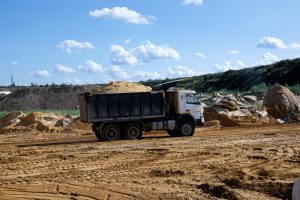The Risks of Hauling Sand
 The North Dakota landscape is frequently dotted with sandbox haulers. These specialized trucks play an important role in transporting frac sand, a key component in the hydraulic fracturing process that fuels our region’s booming oil and gas industry. While these haulers have become part of the local scenery, the drivers behind the wheel face a range of unique risks, including challenging road conditions and the potential health hazards.
The North Dakota landscape is frequently dotted with sandbox haulers. These specialized trucks play an important role in transporting frac sand, a key component in the hydraulic fracturing process that fuels our region’s booming oil and gas industry. While these haulers have become part of the local scenery, the drivers behind the wheel face a range of unique risks, including challenging road conditions and the potential health hazards.
Molly Sizer, a frac sand hauler, told FreightWaves that she loves her job — but faces long and demanding workdays, with schedules stretching up to six days a week and 12-hour shifts. The treacherous conditions are exacerbated by congested traffic on country roads and the proliferation of semi-trucks on narrow two-lane routes.
While Sizer may be able to navigate her truck safely, some drivers do not have that luxury. A young sand hauler from Aberdeen died in January after his semi-truck rolled. About a year ago, there were two crashes in one month: one in McKenzie County on 85, and one in Williams County on 1804. Both involved a sand hauler being hit by a pickup truck.
The dangers frac sand haulers face
Trucks hauling cargo, particularly those involved in the frac sand industry, face various risks and challenges in addition to the challenges that all large truck drivers face (large blind spots, wide turns, and slow braking). The major risks faced by sand haulers include:
- Traffic hazards. Frac sand haulers often navigate through congested and challenging road conditions, including narrow country roads, dirt roads, and two-lane highways. The increased traffic in these areas, with numerous semi-trucks and other vehicles, can lead to deadly accidents.
- Training and skill requirements. Different types of hauling trucks, such as pneumatic and sandbox trucks, have varying training requirements, e.g., pneumatic trucks require more training. Drivers with varying levels of experience and training can be a detriment to road safety. This is especially true during booms, when trucking companies may hire less experienced drivers simply to get more bodies on the road.
- Road conditions. Conditions can be challenging for trucks on less-maintained country roads, especially during adverse weather, where trucks get stuck, damaged, or become involved in accidents. Leased roads can be especially treacherous.
- High volumes and weight. Large quantities of sand–sometimes up to 50 million pounds–are routinely transported to well sites. The weight of the load and volume of sand impacts the stability of the truck, especially during turns or on uneven country roads.
- Silicosis and other lung diseases. Workers at frac sand mining sites are at risk of chronic silicosis due to exposure to silica, a component of sand. A frac sand hauler may be especially vulnerable to silica inhalation during loading and unloading of the cargo. Silica inhalation has long been known to pose health hazards, including serious lung diseases like silicosis and lung cancer.
The greatest risk for frac sand haulers is fatigue
Some operations run 24 hours a day, which means drivers may be coming in and out of sites at any time. That alone increases the risk of drivers being fatigued, but the more pressing issue is that oil and gas drivers have a different set of rules to follow.
Under the Federal Motor Carrier Safety Administration’s Hours of Service rules, truck drivers are limited to 60 hours of driving in total per week (or 70 hours per eight days). After that, there’s a mandatory reset period of 34 hours. But oil and gas drivers? They have an exemption:
- In the instance of drivers of commercial motor vehicles used exclusively in the transportation of oilfield equipment, including the stringing and picking up of pipe used in pipelines, and servicing of the field operations of the natural gas and oil industry, any period of 8 consecutive days may end with the beginning of any off-duty period of 24 or more successive hours.
- In the case of specially trained drivers of commercial motor vehicles that are specially constructed to service oil wells, on-duty time shall not include waiting time at a natural gas or oil well site. Such waiting time shall be recorded as “off duty” for purposes of §§ 395.8 and 395.15, with remarks or annotations to indicate the specific off-duty periods that are waiting time, or on a separate “waiting time” line on the record of duty status to show that off-duty time is also waiting time. Waiting time shall not be included in calculating the 14-hour period in § 395.3(a)(2). Specially trained drivers of such commercial motor vehicles are not eligible to use the provisions of § 395.1(e)(1).
In short, sand haulers don’t have to wait 34 hours; they only have to wait 24. However, any sand hauler driving a sandbox truck (as opposed to a belly dump) is not subject to the exemption that lets them count their waiting time as driving time, which means sandbox haulers may be driving more with fewer rests.
At Larson Law, our experienced Fargo truck accident attorneys understand the stressful and challenging scenarios that sand haulers face. If you were injured while hauling sand due to someone else’s negligence, give us a call in Fargo, or use our contact page to schedule a free consultation. We handle accident cases on a contingency fee basis – we don’t get paid until you do. We maintain additional offices in Bismarck and Minot.

Mark Larson is a Certified Civil Trial Specialist and Certified Civil Pre-Trial Specialist focusing on personal injury, car accidents, wrongful death, and oil field claims. Since 1979, Larson Law has served the injured throughout North Dakota. Read more about Mark V. Larson.
